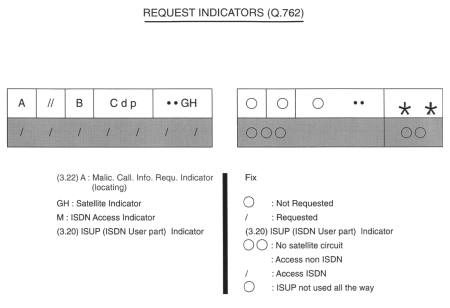INTRA-CENTRAL: INDICATORS UIT-T PHONE-TAPPING
Here are some of the hundreds of ISDN functions possible - the computers centre in SWISSCOM.
- spotting of a malicious call
- recording of a malicious call
- phone numbers identification service
- calls restriction
- data service
- recording of urgent calls
- hotline, immediate or differred
- interception
- intrusion
- password and pin
- prioritary service
- simple line observation : tracing, phone-tapping, sampling service
- selected calls service
- semi-permanent connections
- lines search
- details of the bill for a precise observation
- hotel bills
- detection of coslly calls
- control of the subscriber
This list is not exhaustive.

Indeed; these functions are in the blue book CCITT (indicators), reference Q-762.
Here are some further details.
- original number called : information collected when the call is being diverted, in order to identify the subscriber.
- optional backward call indicators : further information about voice and data.
- information request indicators : used in Swissnet II for identification purposes
- nature of connections indicators : BA Satellite indicators FIX 00 no satellite circuit
- number of the called party : information about the identification of the subscriber who is called, and the identification of the subscriber who is calling.
- satellite indicators : information showing the number of satellite connections used during the call (indicator number 3.23)
- transmission medium requirement : information about the type of transmission device used (speech channel, 64 Kbits/s...)
- Mailbox message : mailbox-name; full; empty (process has read); process has logged a mailbox message.
In 1993, the UIT-Telecommunications succeeded the CCITT which defined the standards of the phone-tapping system between the centrals. The International Union of Telecommunications is located in Geneva, "Place des Nations". The Multimedia Standard : Mpeg was registered by ISO (world organisation which defined the 7 OSI steps/Open Systems Interconnections/ and UIT-T). Thus, these functions are integrated into the digital centrals whatever the brand is. The UIT makes laws, recommendations (I-250) and resolutions.